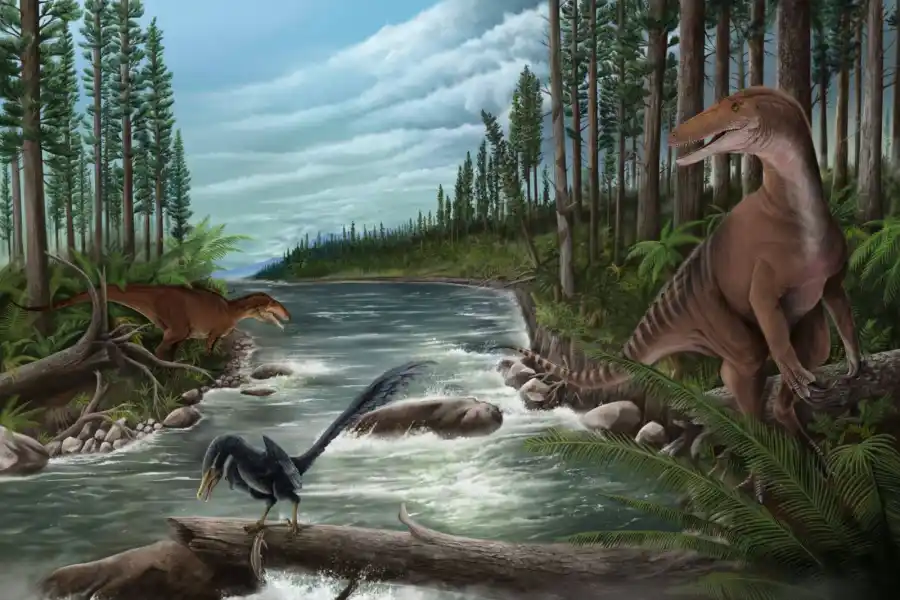
Australian maisema liitukaudella.
Luotto: Jonathan Metzger, Museums Victoria
Luotto: Jonathan Metzger, Museums Victoria
These fossils, excavated along the Victorian coast, date back to the Cretaceous period, between 121 and 108 million years ago. They provide an unprecedented glimpse into the ecosystem of that era. Powerful megaraptorids, reaching lengths of up to 7 meters, coexisted with smaller carcharodontosaurus (2 to 4 meters) and agile unenlagiines, the "southern raptors."
A surprising predator hierarchy
The presence of carcharodontosaurus in Australia is a true surprise for paleontologists. These dinosaurs, which once ruled South America, reached impressive sizes, up to 13 meters, far exceeding the megaraptorids. However, in Australia, the roles seem to be reversed. The megaraptorids dominated, while the carcharodontosaurus were smaller. This peculiarity highlights the uniqueness of the Australian ecosystem during the Cretaceous.This discovery indicates a divergence in the evolution of predators. Indeed, Australia, isolated from the rest of the world at that time, saw its own species of dinosaurs develop. Paleontologists are questioning the factors that favored this distinct evolution. Environmental conditions, prey availability, and competition between species are all avenues to explore.
The absence of large carcharodontosaurus in Australia raises several questions. How can this size difference with their South American cousins be explained? Paleontologists suggest that competition with the already well-established megaraptorids in Australia may have limited their growth. Other factors, such as climatic variations or the availability of certain prey, may also have played a role. More in-depth research will be necessary to fully understand this enigma.
Fossils that speak
Two of the fossils found are the oldest megaraptorids ever discovered. They provide a better understanding of the evolutionary history of this group and suggest that the Australian theropod fauna played a crucial role in the ecosystems of Gondwana. Gondwana was a supercontinent that included Australia, Antarctica, South America, Africa, and India.These fossils testify to faunal exchanges between Australia and South America via Antarctica at the beginning of the Cretaceous. They challenge preconceived notions about the hierarchy of body sizes among Gondwana predators. Australia, with its unique fauna, proves to be a true laboratory of evolution.
The discovery of these fossils is the result of long-term efforts. Museum collections, often overlooked, turn out to be real gold mines of information. Specimens preserved for decades can reveal new secrets thanks to technological advancements and current research. Thus, volunteers, like Melissa Lowery who identified three of the fossils, play a crucial role in these discoveries.
To go further: What is a theropod?
Theropods are a highly diverse group of dinosaurs. They share certain common characteristics. They are bipedal dinosaurs, meaning they primarily moved on their two hind legs. Most were carnivorous, but some evolved to become herbivorous or omnivorous over time. Their forelimbs were often shorter and could be used for grasping prey or for balance.Theropods lived for a long period. Their fossils have been found on all continents. They existed from the Jurassic to the Cretaceous. This great diversity and their presence over a long period make them a fascinating group for paleontologists.
Among the most well-known theropods are Tyrannosaurus rex, Velociraptor, and Spinosaurus. These dinosaurs, popularized by popular culture, have left a mark on the collective imagination. However, the reality is much richer and more complex. Theropods represent a multitude of species, with varied adaptations, that testify to the evolution of life on Earth.